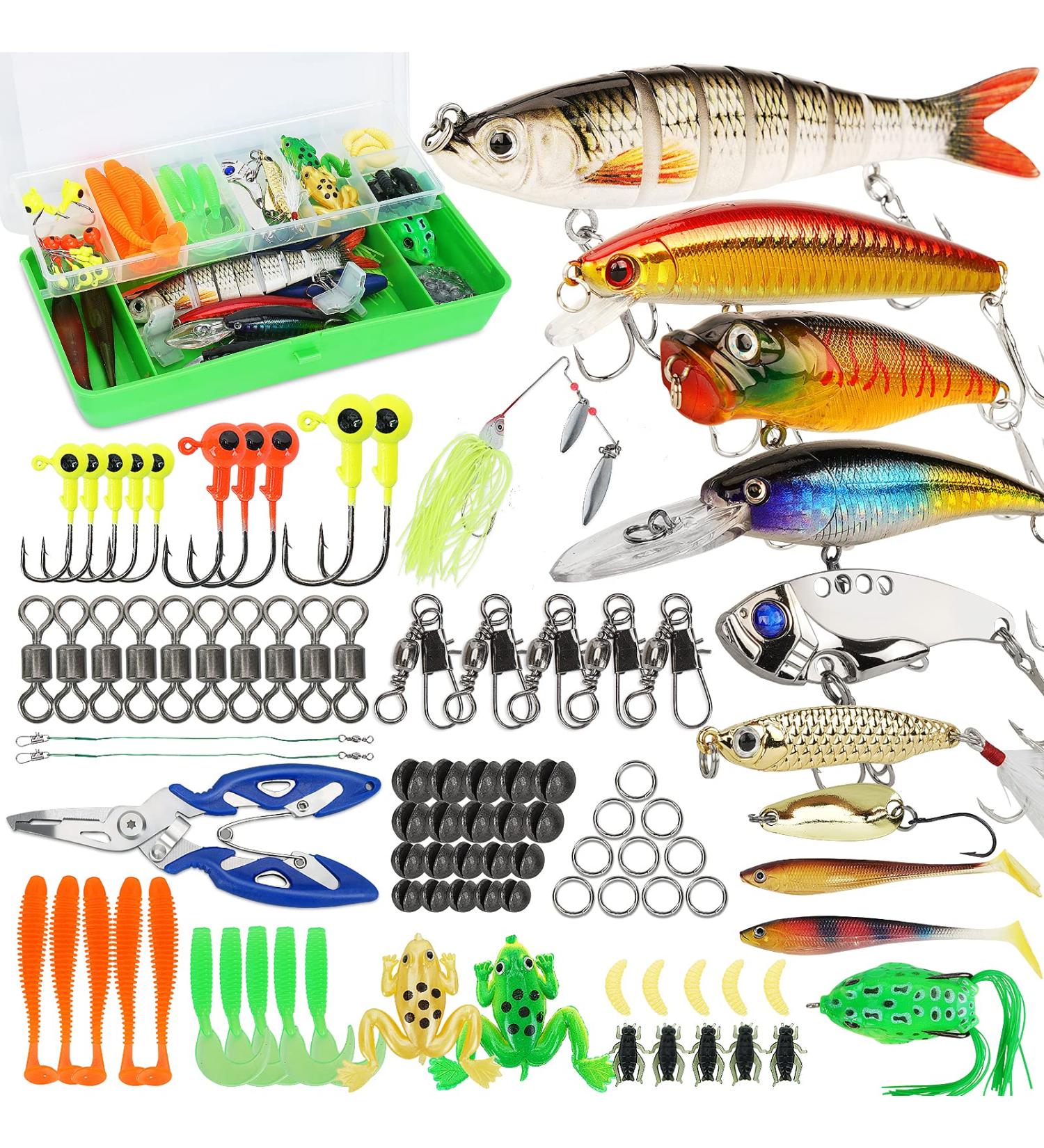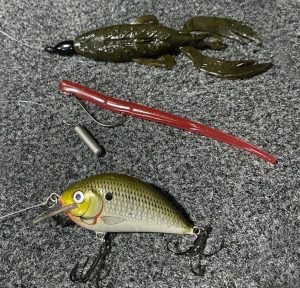How to Match Best Bass Lures South Africa to Local Water Conditions
Wiki Article
Discover the very best Methods for Picking Bass Lures for Your Next Fishing Expedition
Selecting the right bass Lures can considerably influence fishing success. Fishermens must take into consideration different aspects, such as seasonal patterns and water clearness. Comprehending bass actions is important (Bass Fishing Lures). Choosing Lures that simulate natural victim can bring about far better outcomes. Several are uncertain regarding the best methods to implement. What methods should one prioritize to improve their angling experience? The answers exist in analyzing specific conditions and adapting accordinglyUnderstanding Bass Behavior and Habitat
Understanding the nuances of bass habits and habitat is necessary for any type of fishermen aiming to improve their angling success. Bass are often located in different environments, including lakes, rivers, and reservoirs, where they look for framework such as immersed rocks, plants, and fallen trees. Their behavior is greatly affected by water temperature level, light levels, and available forage.Throughout warmer months, bass tend to be a lot more energetic, usually inhabiting shallower waters, while in colder months, they pull back to much deeper areas. Furthermore, bass exhibit patterns of feeding, commonly being extra aggressive during dawn and dusk. They are opportunistic predators, victimizing smaller sized fish, pests, and shellfishes. Recognizing these elements can assist anglers identify prime fishing locations, in addition to the ideal times to fish. Identifying bass behavior in connection to their environment is important for effective fishing, assisting anglers in making notified decisions about where to cast their lines.
Matching Lures to Seasonal Conditions
As fishermens adapt their strategies to altering periods, matching Lures to seasonal conditions comes to be an essential method for improving fishing success. In spring, when bass are emerging from wintertime dormancy, fishermens commonly use spinnerbaits and shallow-running crankbaits to simulate the motions of prey. Summer season requires a shift to topwater Lures or soft plastic worms, as bass seek shade and cooler waters. Throughout the fall, when bass are fattening up before wintertime, bigger Lures that mimic baitfish can be reliable. Winter season requires a more subtle approach; jigs and slow-moving skill baits often generate much better outcomes as bass come to be inactive. Recognizing these seasonal patterns aids anglers choose the ideal lures, thus boosting their opportunities of an effective catch. By straightening lure options with the all-natural behavior of bass throughout the year, fishermens can optimize their fishing experience and improve their general success on the water.The Value of Color Selection
Shade selection plays an essential function in bass fishing, as it can significantly influence a fisher's success. Elements such as water quality, seasonal modifications, and the specific preferences of various bass species all affect which colors are most reliable. Comprehending these aspects permits anglers to make educated selections that enhance their fishing experience.
Water Quality Considerations
When the water clearness differs, picking the best bass attraction shade becomes crucial for drawing in fish. In clear water, all-natural colors such as shad or bluegill patterns have a tendency to be extra efficient, as they mimic the prey bass are accustomed to seeing. Alternatively, in dirty or discolored water, brighter colors like chartreuse or fire tiger can enhance exposure, making it less complicated for bass to spot the appeal. The comparison between the lure and the surrounding atmosphere plays a considerable duty in angling success. Fishermens should likewise consider the time of day; lighter shades may function better in intense sunshine, while darker colors can be more efficient throughout low-light problems. Adjusting appeal color to water clarity maximizes the possibilities of an effective catch.Seasonal Color Scheme
How do seasonal modifications influence bass actions and attraction performance? As temperature levels change throughout the year, bass change their feeding routines and liked habitats, making color selection vital for effective fishing. In spring, when bass generate, brilliant shades like chartreuse can draw in attention. Summer season months often call for even more natural hues, such as environment-friendly pumpkin or shad patterns, as bass seek to assimilate with their environments. During autumn, lively colors like orange and red resemble the changing vegetation, attracting bass as they plan for winter season. In winter months, suppressed tones such as grey or white might be a lot more effective, as bass become tired. Ultimately, understanding seasonal color patterns makes it possible for anglers to choose Lures that reverberate with bass's current habits, enhancing their possibilities of success.
Species-Specific Preferences
Comprehending species-specific choices is crucial for fishermens looking to enhance their attraction choice. Various bass species, such as largemouth and smallmouth, display unique shade preferences based on their environment and feeding behaviors. Largemouth bass usually choose darker shades, particularly in murky waters, where colors like black and dark eco-friendly simulate natural victim. On the other hand, smallmouth bass are most likely to react to brighter colors, such as chartreuse and orange, particularly in clear waters. Additionally, water clearness and light problems can influence these preferences, making it important for fishermens to adjust their lure shade as necessary. By taking into consideration these species-specific choices, anglers can enhance their opportunities of a successful fishing expedition, eventually boosting their total experience on the water.Picking the Right Tempt Type for Various Situations
Choosing the proper lure type for numerous fishing circumstances is important for success on the water. Anglers have to take into consideration factors such as water clarity, climate problems, and the bass's feeding practices. For dirty water, darker-colored attractions, such as jigs or spinnerbaits, can be efficient, as they create a strong shape. In clear water, natural-colored Lures like soft plastics or topwater baits might entice careful bass.When fishing in hefty cover, using heavy jigs or weedless gears can assist browse through barriers without getting. Alternatively, open water situations might take advantage of crankbaits or swimbaits that can cover greater distances. Additionally, during cooler months, slower-moving Lures often tend to be a lot more effective, while warmer conditions may ask for faster retrieves. By adjusting appeal choices to details atmospheres, anglers raise their possibilities of an effective catch.
Trying out With Size and Action

Fishermens commonly trying out a variety of activities and sizes to figure out what works best under differing problems. A slow, refined action could be perfect in cooler water, while a fast, aggressive fetch might be extra Bass Fishing Lures efficient in warmer temperature levels. By meticulously observing the bass's reactions to these variations, anglers can improve their technique and increase their possibilities of an effective catch. Inevitably, the best combination of dimension and action can make a considerable difference on the water.
Checking Out Water Conditions for Better Lure Selections
Understanding water conditions is crucial for choosing the best bass appeal. Factors such as water clarity and temperature can substantially affect fish actions and feeding patterns. By assessing these problems, anglers can make informed choices that improve their opportunities of an effective catch.Assessing Water Clarity
How does water quality affect the performance of bass appeals? Water clarity substantially affects bass habits and the exposure of appeals. In clear water, bass tend to be a lot more cautious, making natural-colored Lures much more reliable as they simulate target closely. Anglers might pick lighter, subtler hues to stay clear of spooking fish. Conversely, in murky or tarnished water, brighter and even more vivid shades stick out, drawing in focus also in reduced exposure conditions. Additionally, the sort of appeal can vary; slower-moving Lures might function better in clear water, while faster, extra hostile presentations can entice bass in murkier settings. Recognizing the clearness of the water allows fishermens to choose Lures that maximize their possibilities of success throughout their fishing journeys.Comprehending Water Temperature Level
As water temperature level fluctuates, it straight affects bass habits and their feeding patterns, making it important for anglers to take into consideration when choosing lures. Generally, bass like warmer temperature levels, commonly between 65 ° F and 75 ° F, where their metabolic process is heightened, resulting in increased feeding task. In cooler water, bass come to be sluggish and may choose slower-moving attractions, such as jigs or soft plastics. Alternatively, during warmer months, faster discussions like crankbaits or topwater Lures can be extra efficient. Fishermens ought to also take into consideration seasonal changes; for instance, spring warming causes hostile feeding as bass prepare to generate. By understanding just how temperature level affects bass, anglers can make enlightened decisions on lure option, significantly boosting their chances of success.Tips for Organizing and Maintaining Your Draw Collection
While many anglers concentrate on picking the appropriate Lures for their following fishing expedition, organizing and keeping an appeal collection is similarly important for enhancing performance and performance. A well-structured collection enables anglers to rapidly situate the Lures they require, reducing time invested rummaging via deal with boxes.To start, fishermens ought to categorize Lures by type-- crankbaits, jigs, or soft plastics-- making it simpler to discover certain options. Utilizing tackle trays or boxes with flexible compartments can aid maintain every little thing organized. Classifying containers streamlines the process better, assisting fast identification.
Regular upkeep is also essential; fishermens must evaluate Lures for signs of wear, such as rusted hooks or harmed paint, and replace them as essential. Cleaning Lures after each journey avoids wear and tear and guarantees long life. By implementing these business and upkeep approaches, anglers can enhance their angling experience and ensure their Lures are constantly in ideal problem.
Often Asked Concerns
What Are the very best Brand Names for Bass Lures?
The very best brands for bass Lures consist of Rapala, Strike King, and Berkley. These brands are renowned for their efficiency, development, and top quality, interesting both newbie and experienced fishermens seeking effective angling experiences.Exactly How Lots of Lures Should I Take on a Trip?
A common fishing expedition must include around 5 to ten attractions, permitting convenience while staying clear of mess. This choice ought to encompass various types and shades to adapt to changing problems and fish choices.Can I Make My Own Bass Lures?
Yes, people can make their very own bass Lures making use of various products and strategies - Best Bass Fishing Lures. Crafting Lures enables for personalization, making it possible for fishermens to try out sizes, shades, and shapes to fit specific fishing problems and choicesWhat's the Ordinary Lifespan of a Bass Draw?
The ordinary lifespan of a bass appeal varies, typically lasting from a few months to numerous years, relying on material top quality, usage frequency, and ecological conditions. Appropriate care can significantly prolong an attraction's use.Exist Details Lures for Night Fishing?
Yes, there specify Lures created for night fishing. Dark shades and Lures that produce resonances, such as spinnerbaits or jigs, commonly draw in bass in low-light problems, improving exposure and triggering predatory reactions.Conversely, in murky or stained water, brighter colors like chartreuse or fire tiger can boost visibility, making it easier for bass to spot the lure. Bigger Lures can draw in bigger bass, while smaller sized Lures might be a lot more efficient for capturing smaller fish. Additionally, the type of appeal can vary; slower-moving Lures could work better in clear water, while faster, a lot more aggressive presentations can attract bass in murkier environments. As water temperature varies, it directly influences bass behavior and their feeding patterns, making it essential for anglers to think about when selecting appeals. While many fishermens focus on picking the best Lures for their next angling trip, preserving an appeal and organizing collection is just as vital for enhancing effectiveness and efficiency.
Report this wiki page